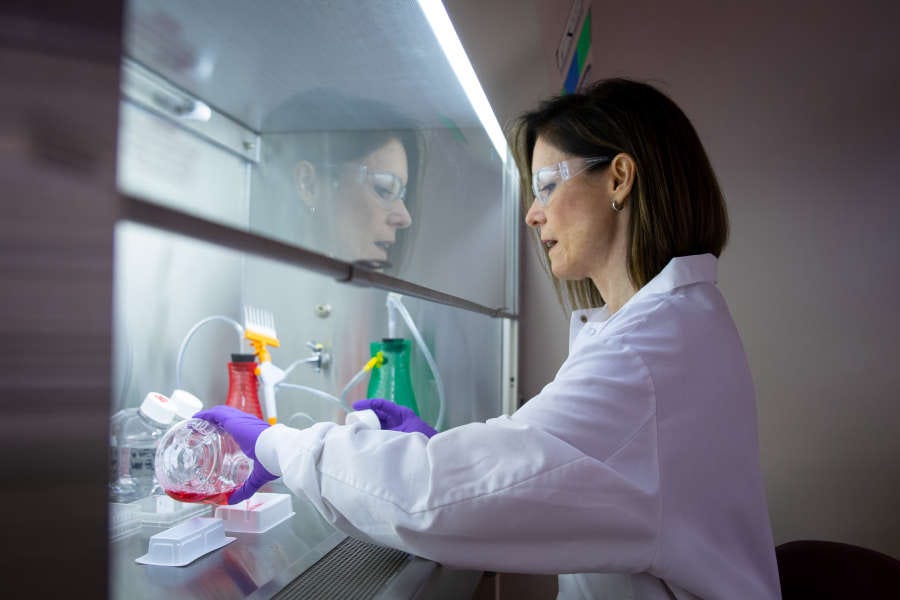IU & Lilly Take ‘Leap of Faith’ to Treat Autoimmune Diseases
 (photo courtesy: Eli Lilly & Co.)
(photo courtesy: Eli Lilly & Co.)
Subscriber Benefit
As a subscriber you can listen to articles at work, in the car, or while you work out. Subscribe NowIn drug development collaborations between university researchers and the private sector, there’s long been hesitation from pharmaceutical companies. IU School of Medicine (IUSM) Senior Research Professor of Medicine Dr. Andrew Dahlem says “intellectual property (IP) is an issue that has created challenges in collaboration.” However, IUSM and Indianapolis-based Eli Lilly and Company say their new $5 million partnership will blaze a trail that, most importantly, benefits patients and inspires a “leap of faith” that the two organizations will create more value together than apart.
“IP, which is the basis for business in the pharmaceutical industry, has often been a stumbling block for collaboration with academic institutions,” say Dahlem, who worked at Lilly for decades, retired, then joined IUSM.
IU and Lilly’s relationship has been built on a legacy of trust and good will, but Dahlem says there are many other examples in which “academic institutions have crossed IP lines.” Conversely, universities are often afraid of losing the valuable knowledge they contribute to a partnership. But Dahlem says the strategic research collaboration between IUSM and Lilly transcends the common hurdles of university and industry partnerships. The five-year partnership is arranged as a master service agreement.
“It resolves the issue of IP upfront and allows Lilly to have comfort in coming to universities—like IU, in this case—and discuss the big, important challenges it has, without fear of being undermined on the IP front,” says Dahlem, who is also clinical pharmacology chief at IUSM. “It’d never be [beneficial] to Lilly to disadvantage IUSM, or to IUSM’s benefit to disadvantage Lilly, so let’s take that leap of faith and collaborate. Let’s take that leap of faith that we’re going to create some value together in an important way, with the uncertainty of exactly how we’re going to do that at the onset.”
The research partnership focuses on autoimmune diseases, which are diseases caused by the body’s immune system attacking healthy cells, and have been notoriously difficult to treat. Some common autoimmune diseases include rheumatoid arthritis, inflammatory bowel disease and Crohn’s disease.
Dahlem says Lilly has “an amazing pipeline” of potential molecules, the building blocks for future drugs, in the autoimmune and immunology areas. Additionally, by conducting clinical trials, the pharmaceutical giant has a deep supply of de-identified genomic information that provides extremely valuable data to help develop potential future drugs.
“Lilly has a wide array of information and data that comes at a great expense; even the nation’s biggest medical school, IU, couldn’t afford to conduct the clinical trials at the cost associated with it,” says Dahlem. “Lilly comes with this unique set of data and unique investment, and [Lilly scientists] can collaborate with IU researchers for analysis and understanding, and then can better direct the medication in a more personalized way.”
The partnership will involve collaboration with the Indiana Clinical and Translational Sciences Institute (CTSI), which is known for its strengths in research analytics. The project will also unleash the power of the Regenstrief Institute, a nationally recognized pioneer and leader in digital health data. By plugging Lilly’s deep amount of data into IU’s profound capabilities in analytics and informatics, project leaders say the partnership will make the data more meaningful.
“IU and CTSI give [Lilly] access to highly thoughtful, trained scientists who employ the highest levels of bioinformatics, machine learning and biostatistics to look for patterns,” says Lilly Senior Research Fellow-Medical Dr. Gary Krishnan. “We are now recognizing there are common molecules and common cells across autoimmune diseases. This allows us to look at what’s common between one autoimmune disease and others. We can take the knowledge we gain from one disease, and ask, ‘Is a portion of that applicable to another disease?’”
The data could be translated into meaningful discoveries, such as why a medication works better in some people than others.
“Sometimes, drugs behave differently in different people or populations. The first challenge Lilly is trying to understand is why some of their breakthrough medications have different benefits for some people rather than others,” say Dahlem. “At the end of the day, everyone wants patients to benefit. That was the motivation when I was at Lilly, and that’s the motivation at IUSM. Let’s bring the two groups together in a collaborative way, and let’s find a way to make patients get better.”
Dahlem says the partnership involved “getting the university to think about IP in a different way.”
Dahlem says senior leaders at IUSM and Lilly understand and can surmount the cultural differences between business and education.
Krishnan says IU’s strengths in informatics and analytics will help Lilly have a more diverse approach to science and problem solving.
